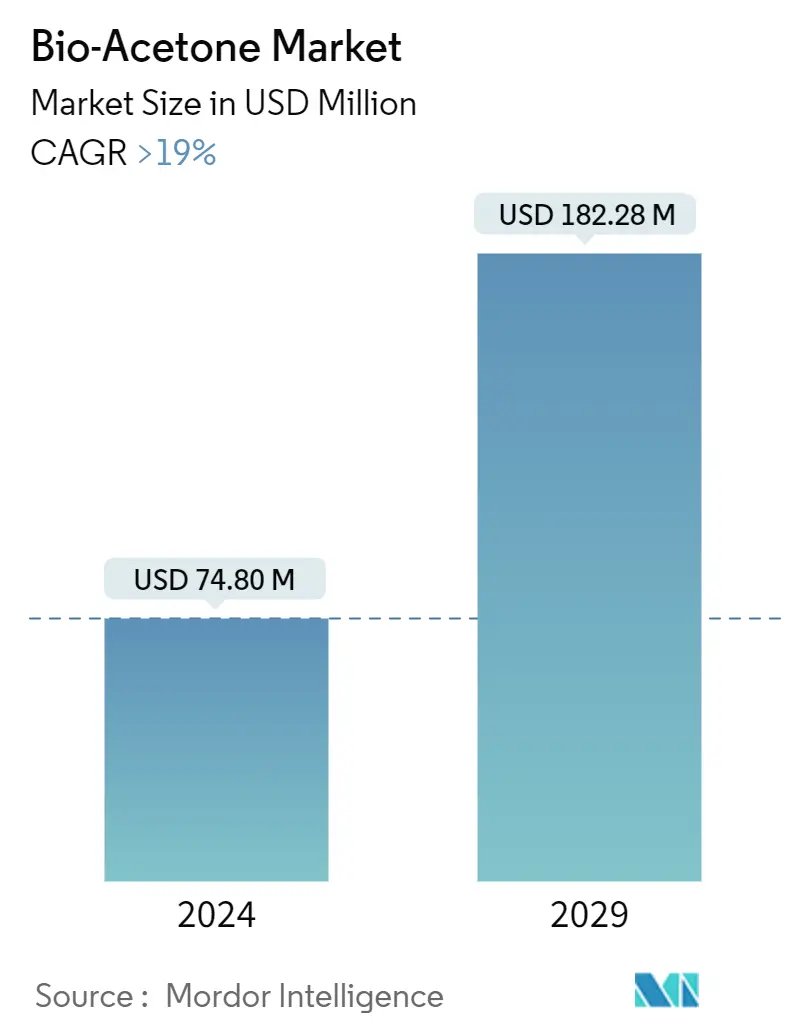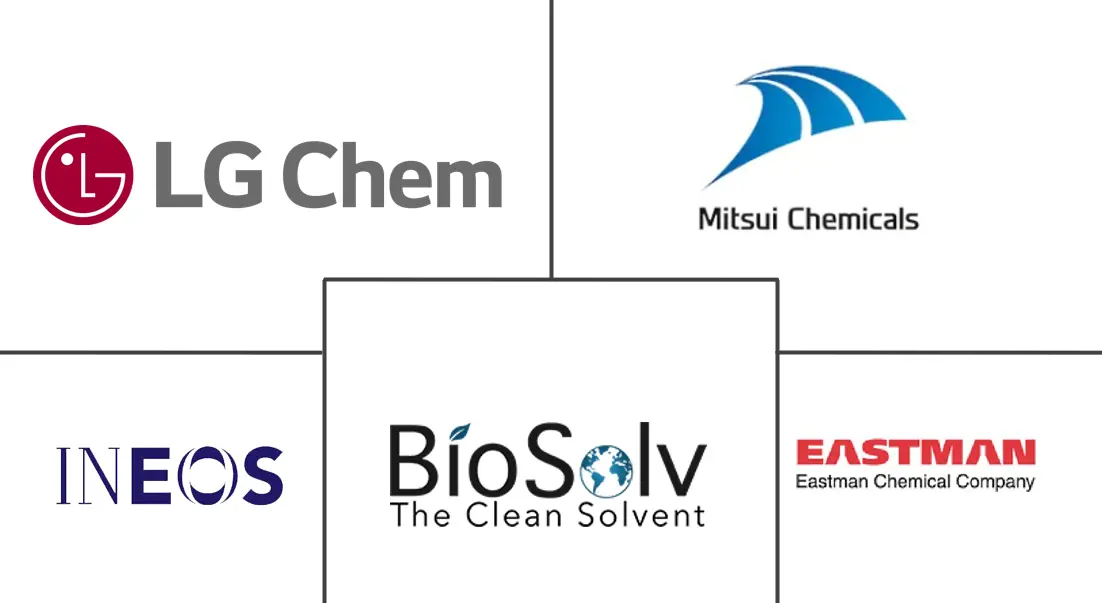Market Size of Bio-Acetone Industry

| Study Period | 2019 - 2029 |
| Market Size (2024) | USD 74.80 Million |
| Market Size (2029) | USD 182.28 Million |
| CAGR (2024 - 2029) | 19.00 % |
| Fastest Growing Market | Europe |
| Largest Market | Europe |
Major Players
*Disclaimer: Major Players sorted in no particular order |
Need a report that reflects how COVID-19 has impacted this market and its growth?
Bio-Acetone Market Analysis
The Bio-Acetone Market size is estimated at USD 74.80 million in 2024, and is expected to reach USD 182.28 million by 2029, growing at a CAGR of greater than 19% during the forecast period (2024-2029).
The COVID-19 pandemic negatively impacted demand in the market due to lockdowns and restrictions imposed by various countries. However, the market recovered in 2021 and returned to pre-pandemic levels in 2022 and 2023 with the rise in applications in various industries.
Over the short term, the demand for bio-acetones is propelled by the demand for bio-based products from various industries, such as paints and coatings.
Conversely, the availability of various alternatives is expected to hinder the market's growth in the future.
The increasing technology for producing bio-based products is expected to create opportunities for the bio-acetone market during the forecast period.
Bio-Acetone Industry Segmentation
Bio-acetone is an alternative to petroleum-based acetone and is produced from various economically friendly raw materials such as corn. It is used as a solvent and thinner in various industries, including paints and coatings.
The Bio-Acetone Market is segmented by material type, application, and country. By type, it is segmented by purity, i.e. <99% and >99%. By application, the market is segmented by plastics, rubber, paints, coatings, and other applications (nail polish remover, cleaning agent, chemicals intermediaries, and others), and by geography, the market is segmented by Asia-Pacific, North America, Europe, South America, and the Middle East and Africa. The report offers market size forecasts for the bio-acetone market in 27 countries across major regions. For each segment, the market sizing and forecasts have been done based on revenue (USD million).
| Type | |
| Purity <99% | |
| Purity >99% |
| Application | |
| Plastics | |
| Rubber | |
| Painting | |
| Other Applications (Nail Polish Remover, Cleaning Agent, Chemicals Intermediaries, etc.) |
| Geography | |||||||||||
| |||||||||||
| |||||||||||
| |||||||||||
| |||||||||||
|
Bio-Acetone Market Size Summary
The bio-acetone market is poised for significant growth, driven by the increasing demand for bio-based products across various industries such as paints, coatings, and automotive. Bio-acetone, a renewable alternative to traditional acetone, offers similar chemical properties and advantages like being non-carcinogenic and biodegradable. Its application in low volatile organic compound (VOC) products is gaining traction due to stringent VOC regulations, particularly in Europe. The automotive sector's shift towards bio-based coatings, spurred by rising electric vehicle production and regulatory compliance, further bolsters the market's expansion. Despite the challenges posed by alternative products, advancements in bio-based technology present promising opportunities for market growth during the forecast period.
The market landscape is characterized by a consolidated group of major players, including LG Chem, Mitsui Chemicals, INEOS, Bio Brands LLC, and Eastman Chemical Company, who are actively pursuing certifications like the International Sustainability & Carbon Certification PLUS to enhance their product offerings. The European Union's VOC Solvents Emission Directive is a significant regulatory driver, mandating the use of low-VOC solvents in industries such as paints and coatings, thereby increasing the demand for bio-acetone. Additionally, the cosmetics industry in Europe, with its substantial market size, is expected to contribute to the rising demand for bio-acetone, particularly as a safer alternative in products like nail polish removers. These factors collectively indicate a robust growth trajectory for the bio-acetone market in the coming years.
Bio-Acetone Market Size - Table of Contents
-
1. MARKET DYNAMICS
-
1.1 Drivers
-
1.1.1 Growing Demand for Bio Based Raw Materials in Various Industrial Applications
-
1.1.2 Increase in VOC Regulations
-
1.1.3 Other Drivers
-
-
1.2 Restraints
-
1.2.1 Availability of Alternatives
-
1.2.2 Other Restraints
-
-
1.3 Industry Value Chain Analysis
-
1.4 Porter's Five Forces Analysis
-
1.4.1 Bargaining Power of Suppliers
-
1.4.2 Bargaining Power of Buyers
-
1.4.3 Threat of New Entrants
-
1.4.4 Threat of Substitute Products and Services
-
1.4.5 Degree of Competition
-
-
-
2. MARKET SEGMENTATION (Market Size In Value)
-
2.1 Type
-
2.1.1 Purity <99%
-
2.1.2 Purity >99%
-
-
2.2 Application
-
2.2.1 Plastics
-
2.2.2 Rubber
-
2.2.3 Painting
-
2.2.4 Other Applications (Nail Polish Remover, Cleaning Agent, Chemicals Intermediaries, etc.)
-
-
2.3 Geography
-
2.3.1 Asia-Pacific
-
2.3.1.1 China
-
2.3.1.2 India
-
2.3.1.3 Japan
-
2.3.1.4 South Korea
-
2.3.1.5 Malaysia
-
2.3.1.6 Thailand
-
2.3.1.7 Indonesia
-
2.3.1.8 Vietnam
-
2.3.1.9 Rest of Asia-Pacific
-
-
2.3.2 North America
-
2.3.2.1 United States
-
2.3.2.2 Canada
-
2.3.2.3 Mexico
-
-
2.3.3 Europe
-
2.3.3.1 Germany
-
2.3.3.2 United Kingdom
-
2.3.3.3 France
-
2.3.3.4 Italy
-
2.3.3.5 Spain
-
2.3.3.6 Turkey
-
2.3.3.7 Russia
-
2.3.3.8 NORDIC Countries
-
2.3.3.9 Rest of Europe
-
-
2.3.4 South America
-
2.3.4.1 Brazil
-
2.3.4.2 Argentina
-
2.3.4.3 Colombia
-
2.3.4.4 Rest of South America
-
-
2.3.5 Middle East and Africa
-
2.3.5.1 Saudi Arabia
-
2.3.5.2 Nigeria
-
2.3.5.3 Qatar
-
2.3.5.4 Egypt
-
2.3.5.5 United Arab Emirates
-
2.3.5.6 South Africa
-
2.3.5.7 Rest of Middle East and Africa
-
-
-
Bio-Acetone Market Size FAQs
How big is the Bio-Acetone Market?
The Bio-Acetone Market size is expected to reach USD 74.80 million in 2024 and grow at a CAGR of greater than 19% to reach USD 182.28 million by 2029.
What is the current Bio-Acetone Market size?
In 2024, the Bio-Acetone Market size is expected to reach USD 74.80 million.

